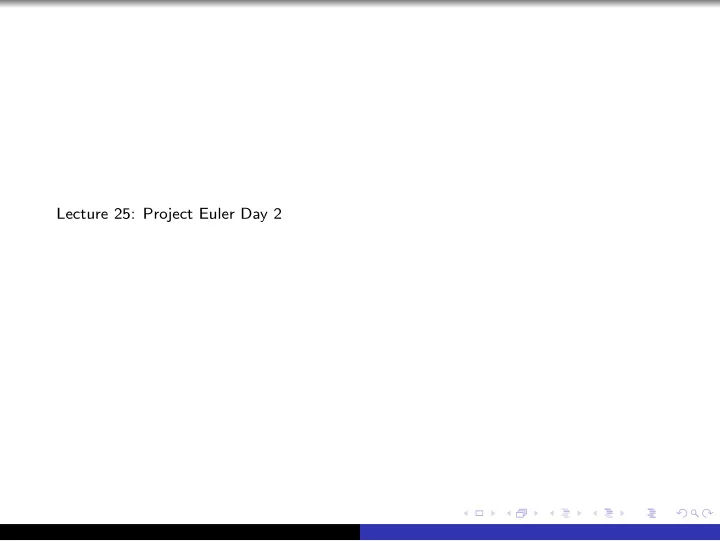

Lecture 25: Project Euler Day 2
Project Euler: 104 The Fibonacci sequence is defined by the recurrence relation: F n = F n − 1 + F n − 2 , where F 1 = 1 and F 2 = 1. It turns out that F 541 , which contains 113 digits, is the first Fibonacci number for which the last nine digits are 1-9 pandigital (contain all the digits 1 to 9, but not necessarily in order). And F 2749 , which contains 575 digits, is the first Fibonacci number for which the first nine digits are 1-9 pandigital. Given that F k is the first Fibonacci number for which the first nine digits AND the last nine digits are 1-9 pandigital, find k .
Project Euler: 112 Working from left-to-right if no digit is exceeded by the digit to its left it is called an increasing number; for example, 134468. Similarly if no digit is exceeded by the digit to its right it is called a decreasing number; for example, 66420. We shall call a positive integer that is neither increasing nor decreasing a “bouncy” number; for example, 155349. Clearly there cannot be any bouncy numbers below one-hundred, but just over half of the numbers below one-thousand (525) are bouncy. In fact, the least number for which the proportion of bouncy numbers first reaches 50% is 538. Surprisingly, bouncy numbers become more and more common and by the time we reach 21780 the proportion of bouncy numbers is equal to 90%. Find the least number for which the proportion of bouncy numbers is exactly 99%.
Project Euler: 92 A number chain is created by continuously adding the square of the digits in a number to form a new number until it has been seen before. For example, 44 → 32 → 13 → 10 → 1 → 1 85 → 89 → 145 → 42 → 20 → 4 → 16 → 37 → 58 → 89 Therefore any chain that arrives at 1 or 89 will become stuck in an endless loop. What is most amazing is that EVERY starting number will eventually arrive at 1 or 89. How many starting numbers below ten million will arrive at 89?
Project Euler: 145 Some positive integers n have the property that the sum( n + reverse( n )) consists entirely of odd (decimal) digits. For instance, 36 + 63 = 99 and 409 + 904 = 1313 . We will call such numbers reversible; so 36, 63, 409, and 904 are reversible. Leading zeroes are not allowed in either n or reverse( n ). There are 120 reversible numbers below one-thousand. How many reversible numbers are there below one-billion (10 9 )?
Recommend
More recommend